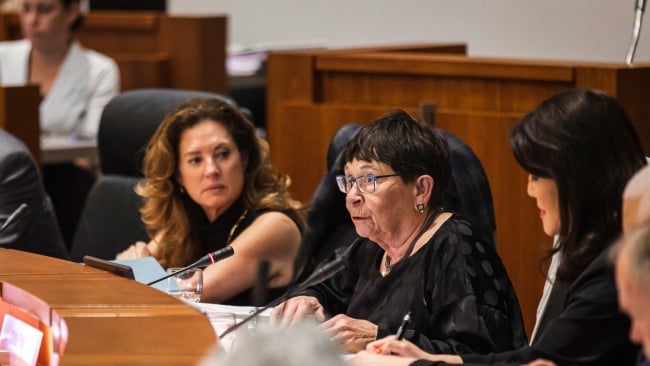You have /5 articles left.
Sign up for a free account or log in.

CSU interim chancellor Jolene Koester comments on the Title IX review after it was presented at a Board of Trustees meeting on May 24.
Jen Cook for California State University
When California State University chancellor Joseph I. Castro resigned last spring amid accusations that he mishandled sexual misconduct allegations against a colleague during his tenure as president of Fresno State, CSU’s Board of Trustees ordered a full external review of the system’s Title IX reporting and investigation processes.
The results of that review, presented to the board last Wednesday by the law firm Cozen O’Connor, are damning. Gina Maisto Smith, chair of Cozen O’Connor’s institutional response group, said the investigation found an “uneven application of policy” among the system’s 23 campuses. In the cases her team reviewed, she said, campus Title IX investigators often came to “incredibly disjointed and frankly unreliable conclusions.”
Associates for Cozen O’Connor said they visited every campus in the system and used feedback from over 18,000 students, staff, faculty members and administrators to build their understanding of the current procedures and inform their recommendations for change.
Among other things, the law firm recommended that CSU hire dedicated staff to oversee Title IX complaints across the system—positions that Maisto Smith said “don’t really exist” at the moment; add resources and training in “trauma-informed Title IX compliance”; and create a well-staffed, formal oversight body at the system level to ensure the accountability of campus officials.
Jolene Koester, who has served as CSU’s interim chancellor since Castro’s resignation, told Inside Higher Ed that the Cozen O’Connor report offered an “unflinching” examination of the system’s Title IX reporting and oversight issues. She added that while the findings “were uncomfortable and difficult to hear,” they present an opportunity for CSU to “strengthen our culture of compliance and our culture of care.”
The review’s findings, delivered verbally to the Board of Trustees, did not include specific figures for the system’s Title IX investigation data; CSU spokesperson Claudia Keith said a full written report would be available in mid- to late June. But a Los Angeles Times analysis of CSU records from last year found that investigations were only completed for about 3 percent of more than 2,600 reports of sexual harassment and misconduct throughout the system.
Koester said she planned to act on the report’s recommendations to increase the role of the chancellor’s office in overseeing the handling of Title IX investigations on individual campuses and to allocate resources to hire and train professional staff devoted to Title IX investigations. She also said she would take a personal leadership role in changing the culture around sexual misconduct and Title IX adjudication across the system.
“This is not a box-checking exercise,” she said. “For me, it’s important that the skepticism with which something like this might be met is responded to with commitment, resources and no equivocation from myself or any of our campus leaders. We are taking these recommendations very seriously.”
A String of ‘Institutional Failures’
The incident that led to Castro’s resignation was just one of many at CSU in recent years in which sexual misconduct allegations went unpunished or were brushed aside. According to an EdSource investigation from last August, 54 CSU faculty members, coaches or other staff members were found responsible for sexual misconduct or discrimination between 2017 and 2021; of those, 30 resigned, were dismissed or otherwise left the system.
The president of Sonoma State University, Judy Sakaki, quit her post last June after she was accused of ignoring a pattern of sexual harassment of university employees by her husband, higher ed lobbyist Patrick McCallum. Cal Maritime is being sued by the parents of a cadet who they say was driven to suicide by the university’s mishandling of a Title IX complaint. In at least one case, a professor found to have violated sexual misconduct policies resigned from one CSU campus only to be hired later at another, according to records obtained by EdSource.
Some of the most dramatic revelations about the system’s failure to address sexual misconduct came in December at Chico State, where allegations of sexual harassment, threats of violence and stalking by a professor sparked outrage—in large part because concerns about his behavior had been raised for years, to little effect.
The professor, David Stachura, reached a settlement agreement with Chico State in 2020 over his alleged affair with a graduate student. A year later he was named an “Outstanding Professor” and shortly after promoted to full professor. The university eventually suspended Stachura and earlier this year filed a restraining order against him after it came to light that he had purchased firearms with which he allegedly planned to intimidate or harm two colleagues who reported his affair. The provost who oversaw the investigation resigned in December.
The Cozen O’Connor report did not address these incidents by name but referenced the broader pattern of investigations being drawn out due to insufficient resources at individual campuses. It also noted that campus leaders with personal biases—such as Sakaki and Castro, who was friends with the colleague he neglected to investigate—may have ignored or attempted to conceal allegations of misconduct against those close to them, behavior that may have been enabled by broader structural problems.
“The poor judgments of a couple of individuals had the ability to poison the water more broadly,” Leslie Gomez, vice chair of Cozen O’Connor’s institutional response group and co-lead on the CSU review, told Inside Higher Ed. “I think what we saw were that challenges in infrastructure led to delays in responsiveness or in oversight, and that’s what allowed community members to come away with the inference that CSU didn’t care … It’s a complicated thing to untangle.”
A few days before the firm’s presentation to the board, in what could be seen as a first test of the system’s new conscientiously top-down response strategy, the Los Angeles Times reported that allegations of misconduct against Framroze Virjee, the president of Cal State Fullerton, were never fully investigated by the university or the system. Virjee, who is set to retire in July, has denied any wrongdoing.
Koester acknowledged the system’s shortcomings in overseeing and enforcing Title IX standards across its campuses and said changes were underway. But she insisted that Virjee’s case was not like the others.
“I’ve publicly committed to one of Cozen O’Connor’s recommendations, that any allegations against campus executive leadership will be referred to the chancellor’s office,” she said. “But Framroze Virjee has been a strong, good leader at Cal State Fullerton.”
Keith, the CSU spokesperson, later told Inside Higher Ed that the L.A. Times article included “unsubstantiated allegations” against Virjee and said CSU provided “a plethora of documents” to the paper ahead of publication, but she declined to go into further detail.
“It’s safe to say we take issue with their reporting,” she said.
Regulatory ‘Wrecking Ball’ or Convenient Scapegoat?
Maisto Smith told Inside Higher Ed that one of the major challenges facing a large university system like CSU is the “ever-shifting tides” of Title IX regulations and compliance since the field was upended by the 2011 Dear Colleague letter and resulting changes by the Department of Education.
“The legal framework spawned in 2011 layered an avalanche of regulation on higher education that has not remained stable, but has shifted,” Smith said. “It’s not just a pendulum swing of the law. It is a wrecking ball of the legal framework for higher education.”
Alexandra Brodsky, a staff attorney at the nonprofit legal advocacy organization Public Justice, said she understands frustrations over byzantine bureaucratic procedures like Title IX compliance, but she is largely skeptical of institutions’ attempts to use them to justify broad failings in their investigations of complaints.
“The shift [in 2011] is the conventional narrative, but the historical aberration here are the [2020] Trump regulations,” she said, which would have occurred largely after CSU’s Title IX missteps. “What we saw under the Obama administration was a reiteration of the same policies that the department had followed since the 1990s … I think it is often B.S. when schools claim they have been victims of an ever-shifting regulatory landscape.”
The deeper issue, Brodsky said, is cultural, not procedural.
“Process is important; I don’t want to undermine that,” she said. “But if you have a culture of sweeping harassment under the rug, that will find a way through new procedures.”
Koester said she recognizes the need for broader cultural change at CSU as well, and she plans to organize the system’s efforts moving forward in a two-pronged approach: build the infrastructure to ensure better compliance, and rebuild the eroded trust of the CSU community.
“There is still a world outside of our universities that frequently accepts as normal, or has been able to set aside, sexual harassment. What we’re striving to do in the university is create a safer, more respectful, honored place than frequently exists in the world around us,” she said. “That’s going to take time, and nobody wants to hear that. But we’re going to see it through.”
Brodsky said it’s become more common for institutions to hire law firms to go over Title IX procedures with a fine-toothed comb, especially when attempting to mark a clear departure from past practices that have come under scrutiny—such as at Michigan State University, which also hired Cozen O’Connor for its 2021 review. She hopes that wave will lead to a gradual change in how higher ed institutions approach allegations of harassment and misconduct.
“We’re seeing more serious external reviews, potentially just because there are more people coming forward saying their cases were mishandled and so more schools feel like they actually have to have a response,” Brodsky said. “Do I think there’s also a PR angle to it? Absolutely. But I’m not so cynical as to think there’s no good intent behind that.”





